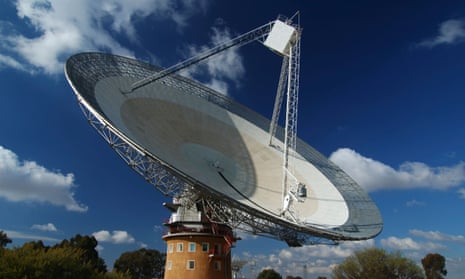Astronomers who have been listening for signals from alien civilisations in the most intensive hunt for extraterrestrials yet have found no evidence of life in its first year in operation.
The Breakthrough Listen project began to eavesdrop on the universe with the Green Bank observatory in West Virginia in January last year, but the most intelligent transmissions the telescope has picked up so far appear to be from satellites or mobile phones and other Earthly devices.
Data released by the project on Thursday revealed eleven of the most promising signals detected, but after close inspection scientists concluded that the radiowaves probably came from humans rather than other intelligent lifeforms.
“These are the signals that look most like what we’d expect to see from a distant technology, but when we looked at them closely were were able to determine that it’s most likely they’re interference,” said Andrew Siemion, the director of the Berkeley Search for Extraterrestrial Intelligence centre.
The Green Bank telescope listened for signals in the range from one to two GHz coming from 692 of the nearest stars to Earth. “Our results mean that fewer than 1% of the stars within 150 light years are constantly transmitting in this range, but it doesn’t mean they are not transmitting at all,” Siemion said.
Studies in the 1960s and 1970s identified the one to two GHz frequency band as the most promising hunting ground for alien transmissions. Having found it to be silent, the astronomers now intend to scour higher frequencies in the hope that alien transmissions lurk there.
“A really important part of the Breakthrough programme is to explore as much of the electromagnetic spectrum, both radiowave and optical signals, as we possibly can,” Siemion said.
The astronomers look for high energy signals at a steady frequency and position in the sky. “The problem is if you take a radio telescope and look for signals like that you find lots and lots, and of course most are coming from our own technology. The big challenge is to discriminate between distant technology and our own technology on Earth.
Funded by the Silicon Valley billionaire Yuri Milner, the $100m project was launched in 2015 as the most ambitious search for alien life to date. The operation began at Green Bank, the largest steerable telescope in the world, but others including the Parkes observatory in New South Wales, Australia, are also involved.
Parkes allows the astronomers to listen for transmissions from stars in the southern skies, including Alpha Centauri and Proxima Centauri. Last year, they discovered what might be a habitable planet in orbit around Proxima Centauri, the nearest star to Earth.
Another observation last year, involving the peculiar behaviour of a distant sun, prompted a flurry of speculation that aliens might have built a megastructure around their home star. Follow-up observations seemed to kibosh the theory, however, when scientists found no evidence of transmissions coming from the region.
